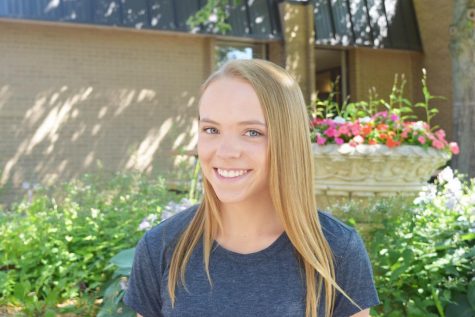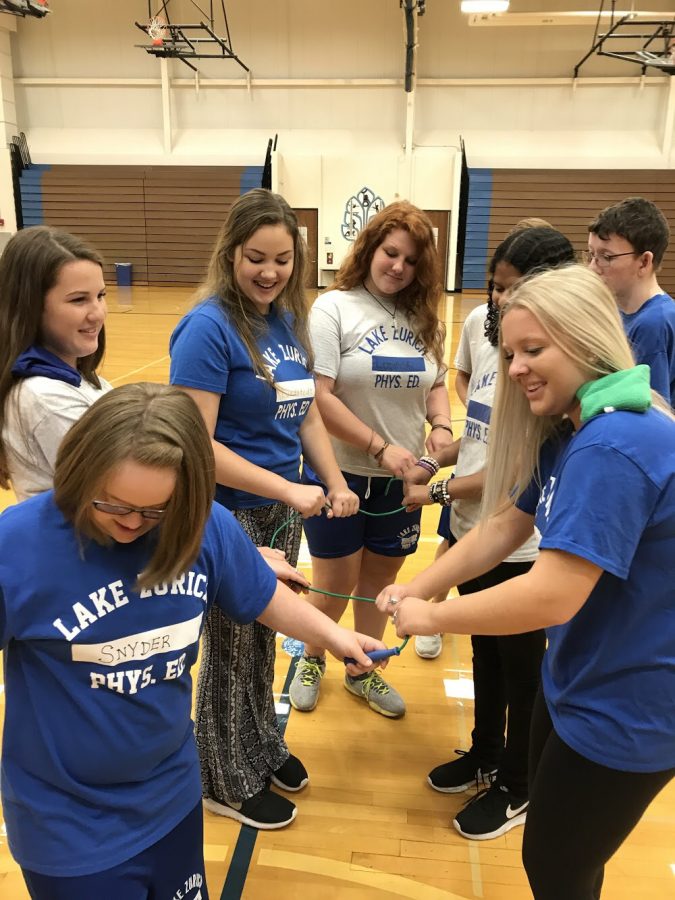Integrated PE benefits from upperclassmen mentors
If you enjoy working with special needs students and want to learn how to mentor others then Integrated PE is the class for you.
Integrated PE, a PE class where junior and senior mentors buddy up with special needs students and switch partners weekly, does not only help the special education students grow as athletes, but the class also aids in the growth of their social skills, according to Mere Carrigan, senior Integrated PE leader.
“We have the big kids who are the students like us, and then we have our buddies who are the special ed kids. Each week we are paired up with one of the kids in a small group, and for that week they’re our buddy,” Carrigan said. “We do all sorts of bonding activities with them, and we just aid them in playing team sports: soccer, volleyball, and that sort of stuff. It’s also a social thing because you’re helping the kids socially grow as they meet new buddies.”
Through the systems of pairing with a different buddy each week, Kayli Antonoff, senior Integrated PE leader, says “it’s a great way to meet all different types of people” because the mentors are constantly learning how to help their buddies.
“I just really like it when everyone is included and they feel like a part of something, and I just really like helping people. So, if I can make someone’s day better, help them, and make them feel like they’re part of a group [then I will],” Antonoff said. “We’re all friends.”
Though the junior and senior leaders help their buddies throughout the class periods, Antonoff says they do the same things as Lifetime Sports and are still pretty competitive.
“So we do all of the same things that Lifetime Sports does, so it’s the same games, activites, sports and everything, but it’s just more inclusive. [For example,] how we split up teams, it’s not based on the number on the team. It’s based on the abilities and the skills of everyone in the class,” Antonoff said. “It’s pretty similar. We’re still pretty competitive with each other. We still have a lot of fun. We get creative with our games. It’s just with special needs students, some of it is with safety, too; some of our students can’t be hit with the ball really hard.”
Although safety is a major reason for many students taking Integrated PE, getting creative with games allows the students to have similar experiences and the same opportunities as any other student.
“The [special needs] kids that are in regular PE classes do not get as much attention from the teachers or a buddy, and it’s hard for some of them to keep up with the other kids. It sounds like we give them almost special treatment, but it’s a lot of getting to know the kids better,” Carrigan said. “As they get more buddies or work with [others] one on one, because we rotate throughout the whole class, each person [learns] what’s good or bad for that buddy and what they work well with and what they don’t. It’s just about learning how they’ll best grow, how they best work with what sport and how they’ll prosper.”
To learn for yourself how these students grow best or if you are truly interested in being an Integrated PE mentor, Antonoff recommends getting involved with special needs activities to get experience and learn how to be patient.
“I think, first, they should join S.N.A.P or Buddy Project just to get involved with special needs activities, and from there, if they enjoy it and they want to do it because they enjoy it and not just because it’s an easy class,” Antonoff said. “That’s also a stereotypical thing. People [say] ‘I’m going to join Integrated because it’s an easy PE, but it’s not. You have to be very patient and figure out new ways to do things.”
Everyone gets so much out of the program, according to Meghan Mowinski, adapted PE teacher and S.N.A.P sponsor, not just the mentors and not just the special needs students.
“The students with special needs were integrated into the gen-ed PE class, and I just felt like we could do more for them and they might get more out of it being in a class where students applied to get in and they were strictly in there to make the students have a positive experience and be more involved, integrated in the class. It’s not just for the students with special needs. I feel like the juniors and seniors get just as much out of it.”

As a senior in her third year on staff, Megan (spelled the right way) will be taking on the role as Magazine Editor-in-Chief of Bear Facts Student Media....

